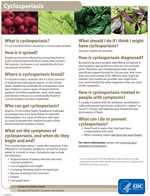Laboratory Guidance
Laboratory Procedures
CDC recommends the following process for confirmatory identification of Cyclospora in stool specimens:
CDC recommends that laboratories obtain confirmation of cases using telediagnosis. Images may be captured from modified acid-fast stained smears or wet mounts examined by UV fluorescence microscopy. Both techniques require concentrated stool specimens. Telediagnosis will allow for rapid laboratory confirmation. Instructions for state health laboratories are found on DPDx.
Microscopy Procedures
It is recommended that concentration procedures be used before microscopic examination. The concentrate can be examined using two preferred techniques: modified acid-fast staining or UV fluorescence microscopy. See DPDx for procedural details.
- Modified Acid-fast Stains: In modified acid-fast stained specimens, Cyclospora oocysts retain their size, but frequently are not perfectly round. In addition, the oocyst wall is less apparent and has a wrinkled appearance, and appears collapsed or distorted on one side. The oocysts are variably stained with the modified acid-fast stain, with different oocysts in the same stained preparation ranging from colorless to deep purple. This variability in staining can lead to misidentification and is a limitation of the procedure.
- UV Fluorescence Microscopy: Cyclospora oocysts exhibit intense blue color when observed under a fluorescence microscope (UV excitation filter set at 330–365 nm). If this filter set is not available, a less intense green fluorescence can be obtained with blue excitation (450–490 nm). Because this fluorescence is very evident, UV fluorescence microscopy is a sensitive technique for rapidly examining stool sediments.
Molecular Analysis
Cyclospora cannot be identified to the species level using microscopy; molecular methods must be used. At CDC, a nested polymerase chain reaction (nested-PCR) assay targeting the 18S rRNA gene is the method of choice for Cyclospora species identification, using DNA extracted from human stool specimens. This method has been used by CDC to examine clinical specimens and food samples in different settings and during outbreak investigations. No PCR tests for Cyclospora have been approved by FDA for in vitro diagnostic use, but PCR is available at CDC and some public health laboratories for this purpose.
For more information about the diagnostic procedures for cyclosporiasis, please visit DPDx.
Teleconferences
Teleconference Q & A
Information provided in this Q&A was developed from and is consistent with information provided during the Q&A period at the end of the Association of Public Health Laboratories (APHL)-sponsored conference call held on August 14, 2013. The call participants were from public health laboratories.
Q: If we want to use the U.S. Food and Drug Administration’s (FDA’s) procedures for detection of Cyclospora from fresh produce by polymerase chain reaction (PCR) and microscopic analysis (BAM Chapter 19a), how can we get FDA’s protocols?
A: FDA has made recommendations for isolation and identification of Cyclospora by PCR analysis. FDA provides detailed protocols addressing these issues, “Detection of Cyclospora and Cryptosporidium from Fresh Produce: Isolation and Identification by Polymerase Chain Reaction (PCR) and Microscopic analysis,” at http://www.fda.gov/Food/FoodScienceResearch/LaboratoryMethods/ucm073638.htm#pcr
Q: Are there any commercial sources for control materials?
A: CDC is not aware of any commercially available control materials.
Q: In your experience, is the intensity of the UV autofluorescence of Cyclospora oocysts low? Do you have any suggestions to increase the fluorescence?
A: The autofluorescence of Cyclospora oocysts typically is bright enough to detect. In addition, the morphologic characteristics of the oocysts should be confirmed by light microscopy. CDC has provided a Bench Aid for laboratory diagnosis of cyclosporiasis (PDF) at http://www.cdc.gov/dpdx/resources/pdf/benchAids/cyclospora_benchaid.pdf.
In general, the longer a specimen is exposed to UV light, the more the fluorescence will fade.
Q: What is the limit of detection for BAM PCR analysis for lettuce?
A: The limit of detection for BAM PCR for lettuce is approximately 50–100 oocysts/25 grams of specimen.
Q: Can Auramine O be used to stain Cyclospora oocysts?
A: CDC has not used Auramine O as a stain for Cyclospora oocysts. CDC has observed protocols using this stain in other laboratories.
Q: During an outbreak investigation, could it become impractical or unnecessary to continue testing to confirm that ill people are infected with Cyclospora?
A: As an outbreak investigation evolves, there may be times when limitations in laboratory resources could lead to reduced or prioritized testing. Ideally, all “cases” included in epidemiologic investigations would be laboratory confirmed. Still, in some settings and investigations, non-laboratory-confirmed “cases” that meet specified criteria can be included in official case counts. Laboratory testing also may be needed or helpful for clinical management.
Q: Has the BioFire FilmArray® Gastrointestinal Panel been cleared by FDA for in vitro diagnostic use?
A: No. FDA has not cleared the BioFire FilmArray® Gastrointestinal Panel. This Gastrointestinal Panel is undergoing clinical and analytical studies.
- Page last reviewed: August 29, 2014
- Page last updated: August 29, 2014
- Content source:



 ShareCompartir
ShareCompartir